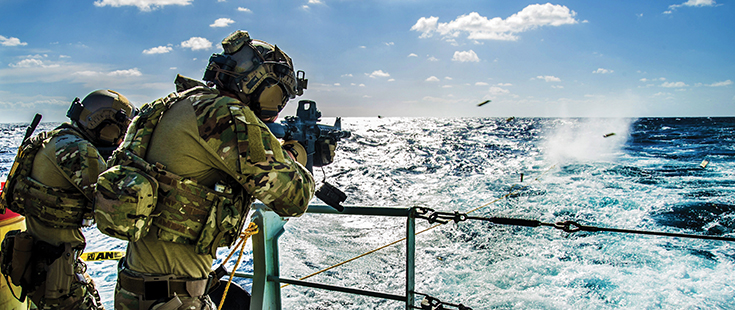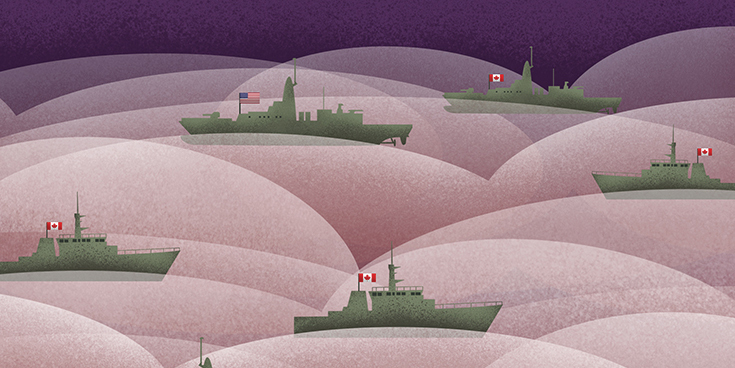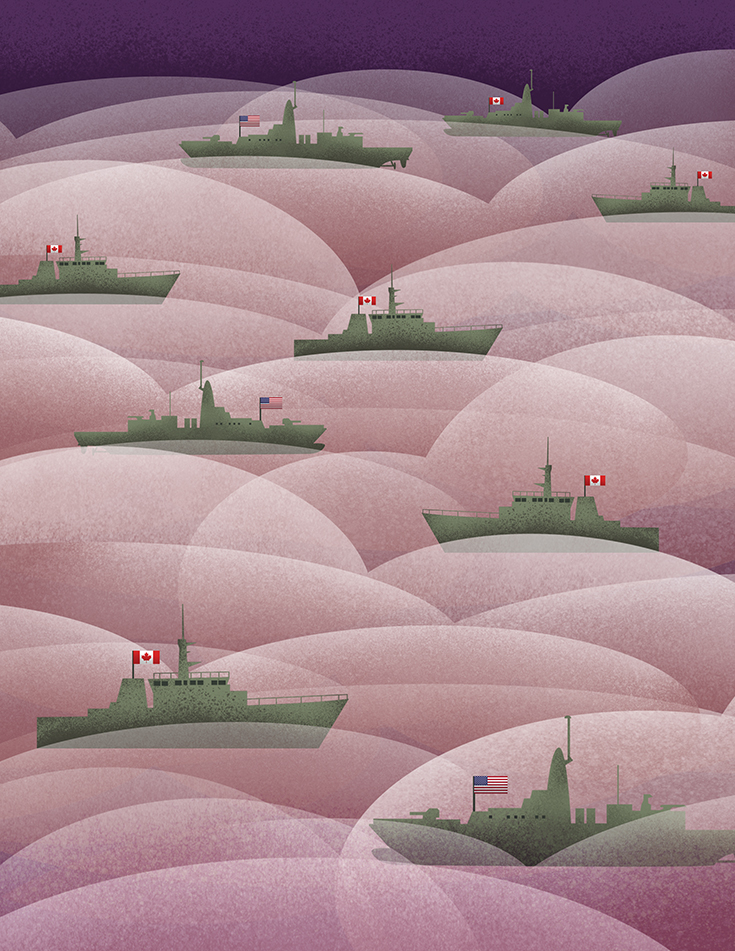Command defends against potential threats from the sea
NORAD MARITIME TEAM
The end of the Cold War did not diminish the importance of the North American Aerospace Defense Command’s (NORAD) aerospace warning and control role, and the events of 9/11 focused leaders on potential threats that resulted in adding maritime warning to NORAD’s responsibility. The complexity of maritime security and the defense of North America stems from the numerous threat vectors encompassing millions of square miles of ocean. The challenge to the security and defense of Canada and the United States is global. Achieving maritime domain awareness is crucial, and no single organization possesses the intelligence and information necessary to accomplish the maritime mission without support from others. Additionally, the sharing of information and intelligence among partners is a significant challenge requiring approved information-sharing agreements, trust between organizations and an understanding of information requirements among maritime agencies. Protecting the maritime approaches and inland waterways of North America requires the development of a shared understanding and awareness of maritime activities.
Maritime threats to Canada and the United States range from small boats operated by transnational criminals to nation state competitors. Cooperation is essential to identify, warn against and counter the complete maritime threat spectrum. In this complex environment, NORAD, through its maritime warning mission, fills a critical need to define and transmit maritime threats to the Canadian and U.S. governments.
Evolving Maritime Mission
NORAD, based in Colorado Springs, Colorado, is one of the most enduring military partnerships of the post-World War II era. NORAD authorities and responsibilities were established in 1958 through a formal agreement between the governments of the U.S. and Canada. The agreement provides binational aerospace warning and aerospace control to alert and, if necessary, defend North America against threats from strategic long-range aviation, intercontinental ballistic missiles and asymmetric threats in the air. Immediately after 9/11, then-U.S. Secretary of Defense Donald Rumsfeld directed enhanced military cooperation between Canada and the U.S. This led to a proposal to expand NORAD beyond its aerospace missions into the maritime domain. An agreement to expand the mission to include maritime warning was formalized with the signing of the 2006 NORAD agreement.
NORAD is uniquely positioned as a binational command with a global area of responsibility. The NORAD commander is directly responsible to both the Canadian and U.S. national security establishments. For threats originating in the maritime domain, maritime warning is NORAD’s responsibility, while maritime homeland defense is a national responsibility assigned to U.S. Northern Command (USNORTHCOM) and Canadian Joint Operations Command (CJOC). The NORAD Maritime Division executes the maritime warning mission through a core group of personnel from the Royal Canadian Navy and the U.S. Navy augmented by civilians and contractors. NORAD does not own maritime sensors nor does it monitor a raw maritime radar picture. Rather, NORAD personnel monitor the common operating picture provided by Canadian and American sources, review operational and intelligence information from numerous sources and initiate information sharing. In addition, two NORAD maritime division personnel work in the NORAD and USNORTHCOM Joint Intelligence Operations Center to provide a dedicated source of maritime intelligence.
Three Pillars of Maritime Warning
The NORAD agreement provides NORAD with the authority to communicate information on North American maritime threats to the U.S. and Canadian governments. Response to a specific threat by the appropriate command, department and/or agency remains a national responsibility. The NORAD Terms of Reference, approved by the Canadian chief of defence and the chairman of the U.S. Joint Chiefs of Staff, specify the tasks that support the accomplishment of the maritime warning mission. The maritime warning mission is supported by three pillars:
Participate in the overall maritime information sharing network.
Develop a comprehensive shared understanding of maritime activities.
Communicate maritime warnings to the governments of Canada and the U.S. for response by the appropriate national commands and/or departments and agencies.
Information Sharing
Information sharing is the foundation of the maritime warning mission. NORAD leverages existing support relationships to formalize and develop habitual routine information and intelligence-sharing practices; identifies and addresses information and intelligence gaps, seams and barriers; and develops new mutual support relationships to advance the mission. NORAD is supported by CJOC, USNORTHCOM, U.S. Africa Command, U.S. European Command, U.S. Pacific Command,
U. S. Southern Command and U.S. Strategic Command. Conversely, NORAD’s maritime warning mission supports these same agencies in the execution of their own maritime missions. These military agencies represent only a limited section of the maritime community of interest. In total, the stakeholders in the maritime community are composed of over 70 military, civilian (tribal, local, state and federal) and private-sector agencies that span security, law enforcement and defense sectors. Many of these organizations have their own intelligence-producing directorates to support their mission in the maritime domain. Some of NORAD’s maritime warning responsibilities are to formalize direct relationships, participate in maritime domain awareness forums and map out information- and intelligence-sharing relationships throughout the maritime community.

A significant challenge to information and intelligence sharing is the restriction in sharing classified information, technical network barriers and policies that inhibit information flow. As a binational command, NORAD is in a unique position to facilitate information sharing between Canada and the U.S. As part of the mission to share information, NORAD is also tasked with identifying and resolving information-sharing challenges in the maritime domain.
Overlapping authorities in the maritime community create a complex environment. In the United States, the U.S. Customs and Border Protection National Targeting Center runs a worldwide program that ensures proper screening of inbound maritime. However, according to federal counterterrorism policy, the FBI is the lead agency for all counterterrorism, including maritime threats. Closer to home, the U.S. Coast Guard is engaged daily in a broad spectrum of operations that include law enforcement, regulation and defense. The U.S. Maritime Administration works with the shipping industry to identify threats worldwide and communicate advisories and alerts, while the U.S. State Department and Global Affairs Canada review and approve operations of foreign military and research vessels in economic exclusion zones and territorial waters. Within Canada, Canadian Marine Security Operations Centres on the East and West coasts include members from Transport Canada, the Canadian Coast Guard, the Royal Canadian Mounted Police and the Department of National Defence, who work to identify threats on the Great Lakes, inland waterways and the Canadian maritime approaches. Additionally, the World Health Organization is charged with providing information on infectious pathogens (e.g., Ebola), which may be spread by maritime cargo and passengers. These myriad organizations demand an overarching entity empowered to ensure efforts are coordinated and information is shared.
The NORAD Terms of Reference authorize direct liaison with any external department or agency outside of the U.S. Department of Defense (DOD) or Canadian Department of National Defence to share information and intelligence quickly among the maritime community of interest. NORAD maritime warning, through the initiation of a classified conference call, can link multiple Canadian and U.S. interagency operations centers via a secure network to gather information on a developing maritime threat or quickly disseminate information. NORAD receives information from the Global Maritime Operational Threat Response Coordination Center, which coordinates a U.S. response to maritime events among multiple federal departments and the White House staff.
NORAD also participates in conferences and working groups focused on submarine and undersea research threats, Arctic operations and surveillance capabilities, and policy development. To facilitate routine and habitual information sharing, NORAD Maritime leads and participates in several regularly occurring maritime information and intelligence synchronization events. Each month, NORAD leads the Maritime Domain Awareness Synchronization secret video teleconference (SVTC), a venue that allows participants from Canada and the U.S. to discuss vessels of interest, future operations and past events and advertise maritime initiatives. Additionally, NORAD participates in the Port Security Group, Atlantic and Pacific Submarine Operations/Intelligence boards, vessel of interest SVTCs and human smuggling VTCs.
NORAD is a tri-chair of the Maritime Stakeholders Conference (MSC) with Transport Canada’s Interdepartmental Marine Security Working Group, and the National Maritime Intelligence Integration Organization (NMIO). This annual event gathers maritime domain awareness (MDA) representatives from both nations to share information, champion efforts to build MDA capacity and promote information sharing. A noteworthy effort backed by the MSC was the expansion of radar coverage in Puget Sound, which straddles the U.S. and Canadian border. The expansion supports binational law enforcement along with the enhancement of information sharing between Canada and the U.S. This conference provides focus for the maritime community participants, including policy recommendations.
In addition to sharing operations and intelligence, NORAD provides its knowledge and perspective to assist agencies in developing maritime policy. Recently, NORAD worked with the DOD executive agent for MDA, who is leading the implementation of the National Vessel of Interest (VOI) lexicon. It provides a standardized language when classifying maritime threats based on threat category, specific threat details and threat level. The VOI lexicon was initially developed in 2007 for use by NORAD and USNORTHCOM to standardize terminology on maritime threats. Over the last decade, NMIO, as the U.S. Office of the Director of National Intelligence’s maritime manager, has further refined the lexicon and broadcast it to a larger audience. Once the policy and concept of operations for national use of the VOI lexicon is completed, it will enable all DOD departments and agencies to delineate specific reporting criteria and track threats using a common language.
Developing Shared Understanding
The second pillar of NORAD’s maritime mission is to develop a comprehensive shared understanding of maritime activities. This task involves processing and disseminating intelligence data and operational information to gain maritime awareness. Furthermore, it involves validation, characterization and assessment of a potential attack or actual attack against North America by traditional or asymmetric maritime threats.
Developing a common operational picture is a constant challenge because multiple classified and unclassified systems form the picture of surface and subsurface activity. Global Command and Control System, SIPR Google Earth, Agile Client, Situational Awareness Advanced Analytics, Automatic Identification System feeds and space-based systems provide various pieces of the MDA puzzle. There are dozens more. Layering these feeds and combining more information and intelligence produces a truly comprehensive maritime picture.
Communicating Warning
The third pillar within NORAD’s maritime warning is communication. Sharing information and developing MDA is important, but the effort is futile if NORAD cannot communicate maritime warnings to the Canadian and U.S. governments. Maritime warning is subdivided into maritime advisories and maritime warnings, depending upon a variety of criteria, including the capability of the threat, its location and assessment of its intent. Regardless of which designation is used, advisories and warnings are promulgated through message traffic and classified email to inform senior decision-makers in both governments of specific threats or potential attacks. NORAD’s classified conference call may also be used to promulgate the contents of the advisory or warning.
In the absence of a global synchronizing agency specifically authorized to develop a comprehensive maritime picture, NORAD’s greatest value is to provide redundancy in assessing the maritime picture and ensure that information and intelligence are shared among a diverse group of binational participants. NORAD is uniquely positioned as a member of the “Tri-Commands,” which includes USNORTHCOM and CJOC, to champion the cooperation and information sharing necessary to ensure the safety and security of North America from all maritime threats.


